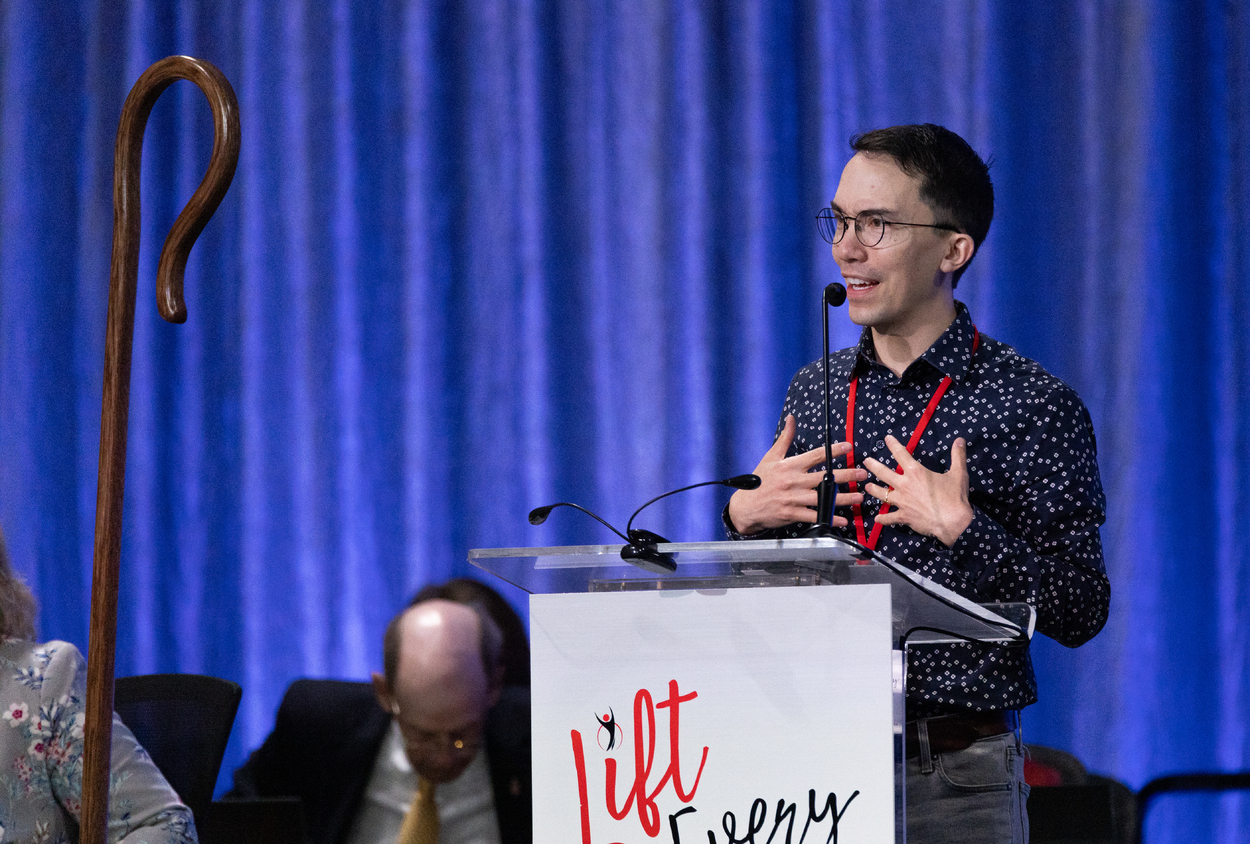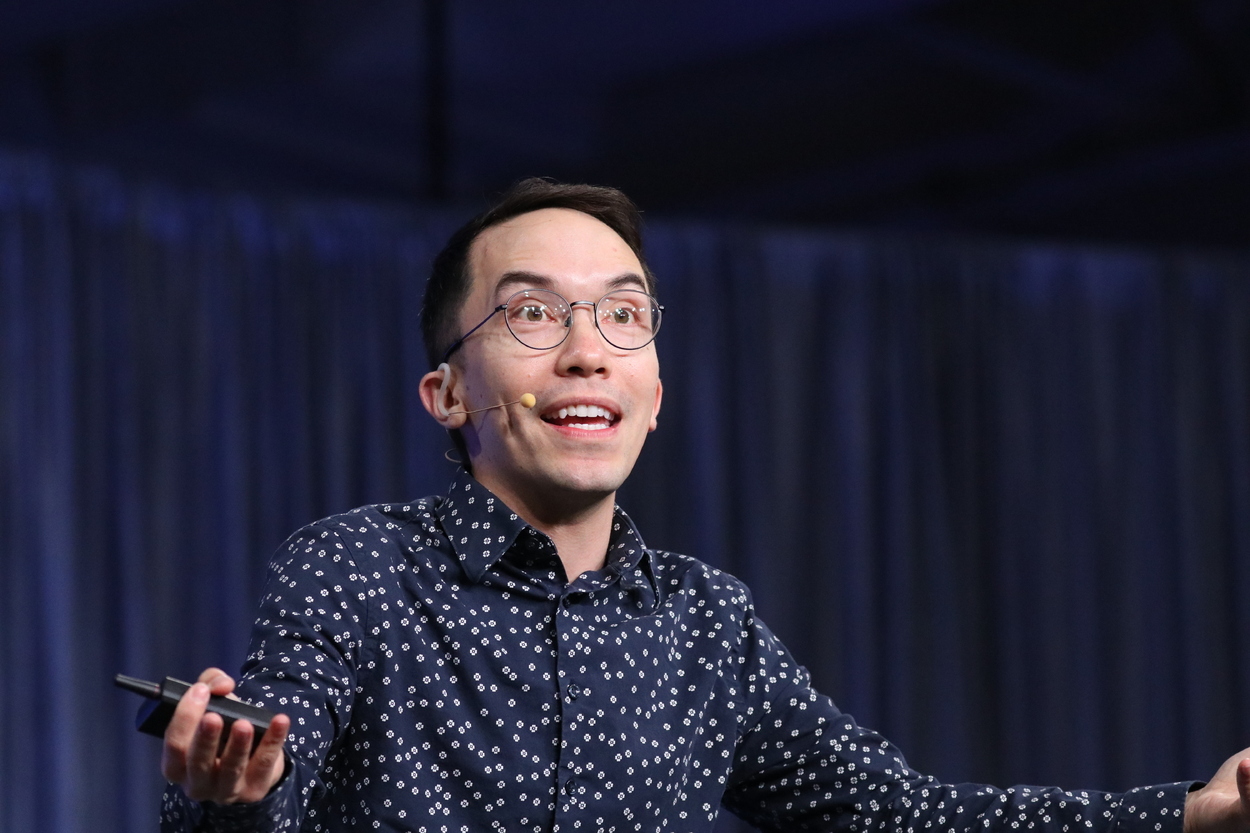
Spiritual innovations and the future of church

Rev. Tyler Sit, Minnesota Conference speaks to attendees about spiritual innvotation.
What does spiritual innovation look like today? Rev. Tyler Sit, church planter and pastor of New City Church and Northeast UMC in Minneapolis, explored that question in a presentation to North Central Jurisdictional Conference attendees.
He gave an overview of the Illuminating Spiritual Innovation study from the Sacred Design Lab at Harvard University, which included 100 interviews with people from 37 countries and many faiths. Drawing partly on his own experience planting a church focused on environmental justice and radical inclusion, he gave an example of what each of the four themes of the study look like from a United Methodist lens.
Technologies of spirit
The study looked at examples, such as a website where you can book a blessing in any of 3600 temples across India.
United Methodist angle: At NCC, a member of the preaching team, Jean Carlos, has a thriving TikTok following. He can reach ten times as many people on TikTok as he can in the physical church. He gets messages from people in Alabama who have no nearby safe and affirming church, but who can engage in faith through Carlos’ TikTok. Circle is an app that serves as the “community plaza” for NCC members. It is a different use of technology than one person broadcasting a message on TikTok, one that provides deeper community care.
Sit asks us to consider how we can leverage the Methodist tradition on social media. “My church needs to be on social media to reach ‘the youths’” is insufficient. We should be asking, “What is the micro transformation that we are inciting?” and “What are we inviting people to?”
Resistance reclamation
This theme is essentially about decolonization of faith. For example, in New Zealand, indigenous communities are bringing historically banned spiritual practices to the mainstream.
United Methodist angle: In the United States, billions of dollars of church property will change hands in the next ten years. As we ask ourselves how we can maintain Christian spiritual witness with fewer and different physical church buildings, there is a great opportunity for centering decolonization and the Land Back movement. Sit recommends the book, “Gone for Good: Negotiating the coming wave of church property transition” by Mark Elsdon.

Sit gave an overview of Illuminating Spiritual Innovation study.
Embodied experience
The study discussed the Extreme Way of the Cross, where tens of thousands of Roman Catholics in Poland embark on a 40-kilometer nighttime hike, each carrying a cross to shrines along the way. Sit pointed out that simultaneously while tech’s influence is expanding in our lives, there is an increasingly deep desire for physical spiritual experiences.
United Methodist angle: Sit described the Incarnation Fund, which supports BIPOC members of NCC in accessing therapy, spiritual direction, and nature-based retreats from BIPOC therapists and practitioners. Only 2.7 percent of Minnesotan mental health clinicians are Black*, and BIPOC people seeking care from people that share their experience of racial trauma usually have to pay out of network costs. This fund bridges the gap. This is not charity, but a mental health reparation fund: a step in making things right in our community, said Sit.
Secular spirituality
Our culture is exploring practices like mindfulness, but taken out of their original spiritual context—for good or ill. For example: the Skylight app offers daily meditation. It is not religious, but funded by the Mormon Church, which says it creates a path toward God for the next generation.
United Methodist angle: Sit suggests we pray about what we define as the non-negotiables for something to be a United Methodist ministry and what we can compromise on. Can we fund ministries that are experimental? Can we renegotiate what we consider secular?
“Tyler reminded us that it's not an either-or between digital ministry and embodied experience. In order to be the church, we need both online community building and digital evangelism. But we must also recognize that people are hungry for physical, embodied experiences that bring us closer to God and to each other,” said Walker Brault, one of Minnesota’s lay alternate delegates.
In closing, Sit urged all who lead in their church and community, “I pray that you may be able to define the moment we are in now.”
More resources:
IntersectNetwork.co
“Where We Meet: A Lenten Study of Systems, Stories, and Hope” by Rachel Gilmore, Candace Lewis, Tyler Sit, and Matt Temple
“Staying Awake: The Gospel for Changemakers” by Tyler Sit
Creation, It Rings worship songs by Brian Schroeder
*Minnesota Department of Health’ Healthcare Workforce Survey, Oct-Dec. 2021